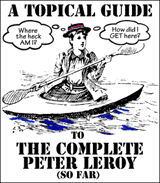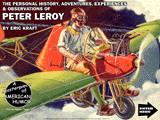
by Mark Dorset
Alan Wachtel contributes this commentary:
The Dorset
Diagram . . . was eerily prefigured by a passage in Mrs. Miniver,
[PURCHASE
OPPORTUNITY] a best-selling World War II-era novel by
Jan Struther that was later made into a hugely successful motion picture
[PURCHASE
OPPORTUNITY]. . . . The passage was reprinted by Clifton
Fadiman in The Mathematical Magpie, [PURCHASE
OPPORTUNITY] one of two anthologies of stories, essays,
rhymes, and assorted fragments based on mathematical themes that he edited.
“Dorset” wrote:
“[T]he Venn diagram that depicts the product of the multiplication (in the logical sense) of two classes can be used to depict the product of that complex operation . . . that we call love . . . The linking image is particularly nice, I think, because the diagram resembles two linked rings. . . .“Struther” (a pseudonym for Mrs. Joyce Maxtone Graham, nee Anstruther—in other words, “J. Anstruther”) wrote:
“Over the years some lovers’ circles become so overlapped that only the thinnest crescents of lunes remain at the outer edges . . . they fill the lens of love so full, . . . become so completely a couple that they belong together in [a] strong way . . .”
She saw every relationship as a pair of intersecting circles. It would seem at first glance that the more they overlapped the better the relationship; but this is not so. Beyond a certain point the law of diminishing returns sets in, and there are not enough private resources left on either side to enrich the life that is shared. Probably perfection is reached when the area of the two outer crescents, added together, is exactly equal to that of the leaf-shaped piece in the middle. On paper there must be some neat mathematical formula for arriving at this; in life, none.
It seems that certain mathematicians took this literary challenge literally, and Fadiman follows it with an excerpt from “Ingenious Mathematical Problems and Methods,” by L. A. Graham, who had evidently posed the problem in a mathematics journal. Graham gives a solution by William W. Johnson of Cleveland for the general case of unequal circles. The analysis isn’t difficult, but the resulting transcendental equation is messy and can’t be solved exactly. When the circles are of equal size, the equation is much simpler, but it still can be solved only approximately. Here transcendental doesn’t mean the school of Emerson and Thoreau; like natural, irrational, and imaginary, it’s a technical term used by mathematicians to refer to certain types of numbers. Graham and Johnson, however, can’t resist remarking on the analogy between social and mathematical problems of transcendent difficulty. (And if I understand Struther’s reply on being shown the solution, the mathematical journal was called the Dial, which was also the name of Emerson’s periodical.)
Alan Wachtel
E-mail it to me, Mark Dorset.

 Here
are a couple of swell ideas from Eric Kraft's vivacious publicist, Candi
Lee Manning:
Here
are a couple of swell ideas from Eric Kraft's vivacious publicist, Candi
Lee Manning:
